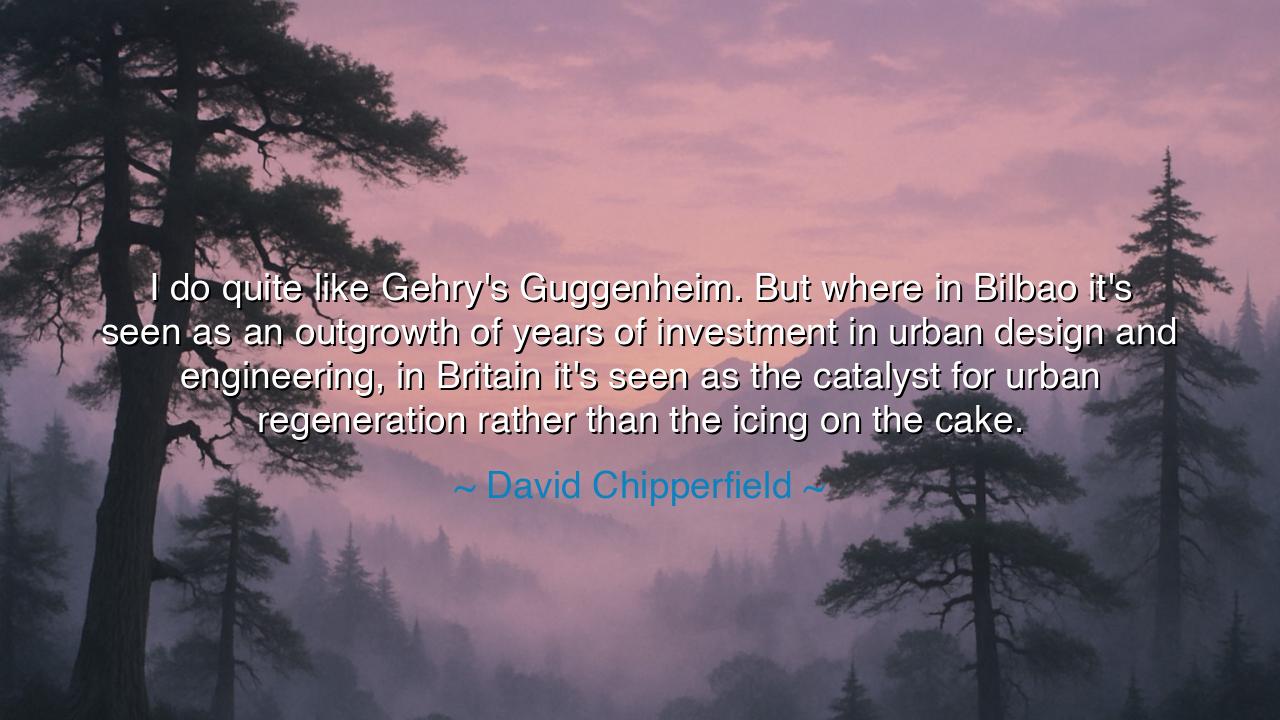
I do quite like Gehry's Guggenheim. But where in Bilbao it's seen
I do quite like Gehry's Guggenheim. But where in Bilbao it's seen as an outgrowth of years of investment in urban design and engineering, in Britain it's seen as the catalyst for urban regeneration rather than the icing on the cake.






The architect David Chipperfield, in reflecting upon Frank Gehry’s Guggenheim Museum in Bilbao, spoke words of quiet yet profound insight: “I do quite like Gehry's Guggenheim. But where in Bilbao it's seen as an outgrowth of years of investment in urban design and engineering, in Britain it's seen as the catalyst for urban regeneration rather than the icing on the cake.” To understand these words is to glimpse the eternal tension between substance and spectacle, between the patient crafting of a foundation and the sudden craving for a miracle. For Chipperfield speaks not only of buildings, but of civilizations—of how societies either build from the ground up, or reach for the heavens before they have laid their stones.
In Bilbao, Gehry’s shimmering masterpiece rose not as a solitary miracle, but as the culmination of decades of devotion. Beneath its curves lay unseen layers of planning, engineering, and faith in the city itself. The Guggenheim there was the fruit of patience, the icing upon the cake that had long been baked through the labor of many hands. Thus, when it arrived, it was not an alien spectacle thrust upon the people—it was a mirror reflecting what Bilbao had already become: resilient, reborn, and ready for wonder. True transformation, Chipperfield reminds us, is the result, not the cause, of a people’s long perseverance.
Yet in his comparison lies a quiet warning. In his homeland of Britain, the Guggenheim is admired not for what it signifies, but for what people wish it could do. It is seen as the catalyst—the spark that might awaken a sleeping city overnight. This, Chipperfield mourns, is the folly of those who seek beauty without foundation, fame without faith, regeneration without roots. A building, however splendid, cannot redeem a people’s neglect of their own streets, their own crafts, their own communities. Just as a crown cannot make a king wise, a grand museum cannot make a city whole.
History is rich with this lesson. Consider Rome, that ancient city whose greatness was not born in marble, but in infrastructure—in aqueducts, roads, laws, and discipline. Its temples stood not as causes of empire but as its celebration, the visible song of an invisible order. Yet when later empires forgot the groundwork and built only for glory, their monuments became hollow shells. The Parthenon, the Palace of Versailles, the Taj Mahal—all are splendors that outlasted the societies that misunderstood them. They remind us that architecture without ethos is vanity, and that no beauty can redeem neglect.
So too, in every endeavor of life, the wise must remember: the icing comes only after the cake is baked. To seek transformation through spectacle is to build upon sand. The artist who seeks fame before mastery, the nation that seeks monuments before equity, the person who seeks glory before growth—all suffer the same fate: the collapse of what was never grounded. The Guggenheim of Bilbao stands as a triumph not of form alone, but of sequence, of order, of a people who labored long before the light touched their skyline.
Therefore, let this be the teaching: Do not worship the visible before you have honored the invisible. Build your foundations first—in skill, in virtue, in community. Let your grand gestures come only when they rest upon the patient strength of unseen effort. The greatest cities, like the greatest souls, shine not because of their adornments, but because of the quiet strength beneath them.
And to all who dream of renewal—whether of cities or of selves—Chipperfield’s wisdom is a torch: do not rush to construct your Guggenheim before you have built your Bilbao. Invest first in the infrastructure of meaning—in thought, in craftsmanship, in the daily labor of integrity. For only when the roots are deep can the branches rise high. And only when the ground is tended can beauty truly become the icing on the cake, and not a fleeting decoration upon the ruins of neglect.






AAdministratorAdministrator
Welcome, honored guests. Please leave a comment, we will respond soon